Emily Lakdawalla • Jan 26, 2015
At last! A slew of OSIRIS images shows fascinating landscapes on Rosetta's comet
Last week a suite of eight peer-reviewed papers were published in Science magazine, detailing the first results of the Rosetta mission. The papers are open-access, so you can go read them all if you want. And don't miss the supplemental materials! The publication of these papers means that the OSIRIS camera team has finally released a large quantity of closeup images of comet Churyumov-Gerasimenko, taken in August and September of last year. Since OSIRIS images and derived data products are such a rare treat I figured I'd post them all here and discuss them based on the two papers and also my notes from the Rosetta presentations at the American Geophysical Union (AGU) meeting, which I never wrote up because I lacked the images to illustrate them!
Two papers concerned these images: "On the nucleus structure and activity of comet 67P/Churyumov-Gerasimenko", by Holger Sierks and coauthors, which I'll refer to as the nucleus paper, and "The morphological diversity of comet 67P/Churyumov-Gerasimenko", by Nicolas Thomas et al, which I'll call the morphology paper. The nucleus paper primarily described the images and the basic properties of the comet, while the morphology one ventured a little deeper into the fascinating landscapes on the comet's surface.
First, some geographical terminology. There are now agreed-upon names for 19 geomorphic regions on the comet, using names from Egyptian mythology. Regions on the head have names of female deities, while regions on the body have names of male deities. In the supplementary material to the morphology paper they say that the boundaries between regions were drawn "at sharp changes in surface morphology (e.g., rough vs smooth surface) or clear structural/ topographical boundaries (e.g., ridge or edge of a depression)." One of the speakers at AGU -- I no longer remember who -- got a laugh out of the audience by pointing out that there is a location on the comet that is now named the "Hapi-Babi region."
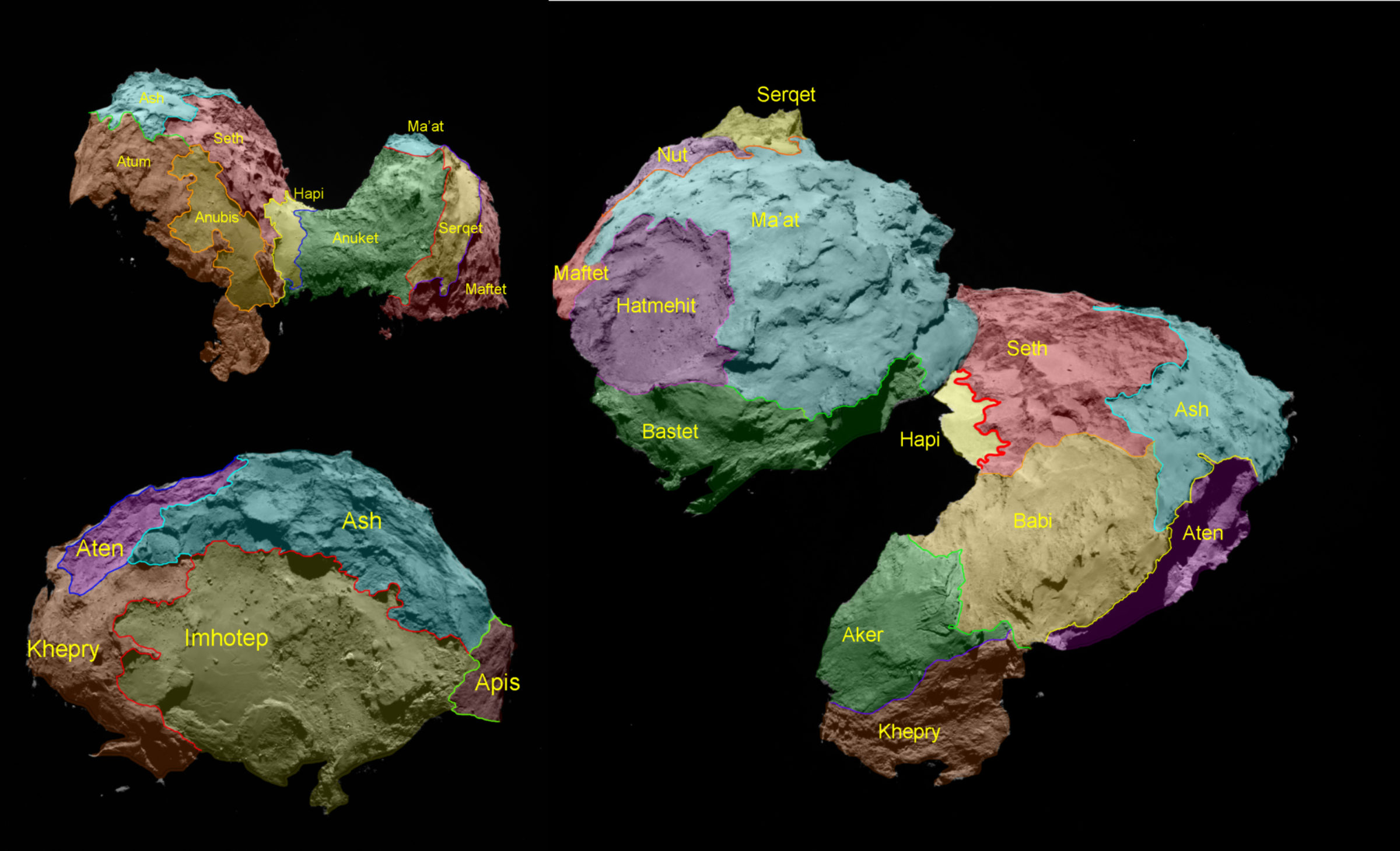
Having geographical names makes it easier and more precise to begin to discuss comet morphology and activity. For instance, the nucleus paper could state that most of the observed comet activity originated from the Hapi region. That's quite curious, because modeling indicates that Hapi receives less total energy input (because of shadowing) than the highest-latitude parts of the two comet lobes. "This suggests a large compositional or structural difference in Hapi relative to other regions," the paper states.
So far, Rosetta has imaged only 70% of the comet's surface, because of the season -- the south pole is in permanent winter shadow. The comet reaches equinox in May, and the south pole will be well illuminated when the comet is at perihelion in august. The lack of imaging in the south makes it a bit of a challenge to estimate comet nucleus properties like volume and therefore density, but the OSIRIS team was able to use data from the MIRO microwave radiometer to coarsely map the topography of the unlit south pole, completing their shape model. The team speculates that once we do see the south pole, it might look dramatically different from other areas of the comet, because it receives much more intense heating for much shorter time than the northern hemisphere does.
Here's a summary of the physical properties of the comet as presented in all the Science papers:
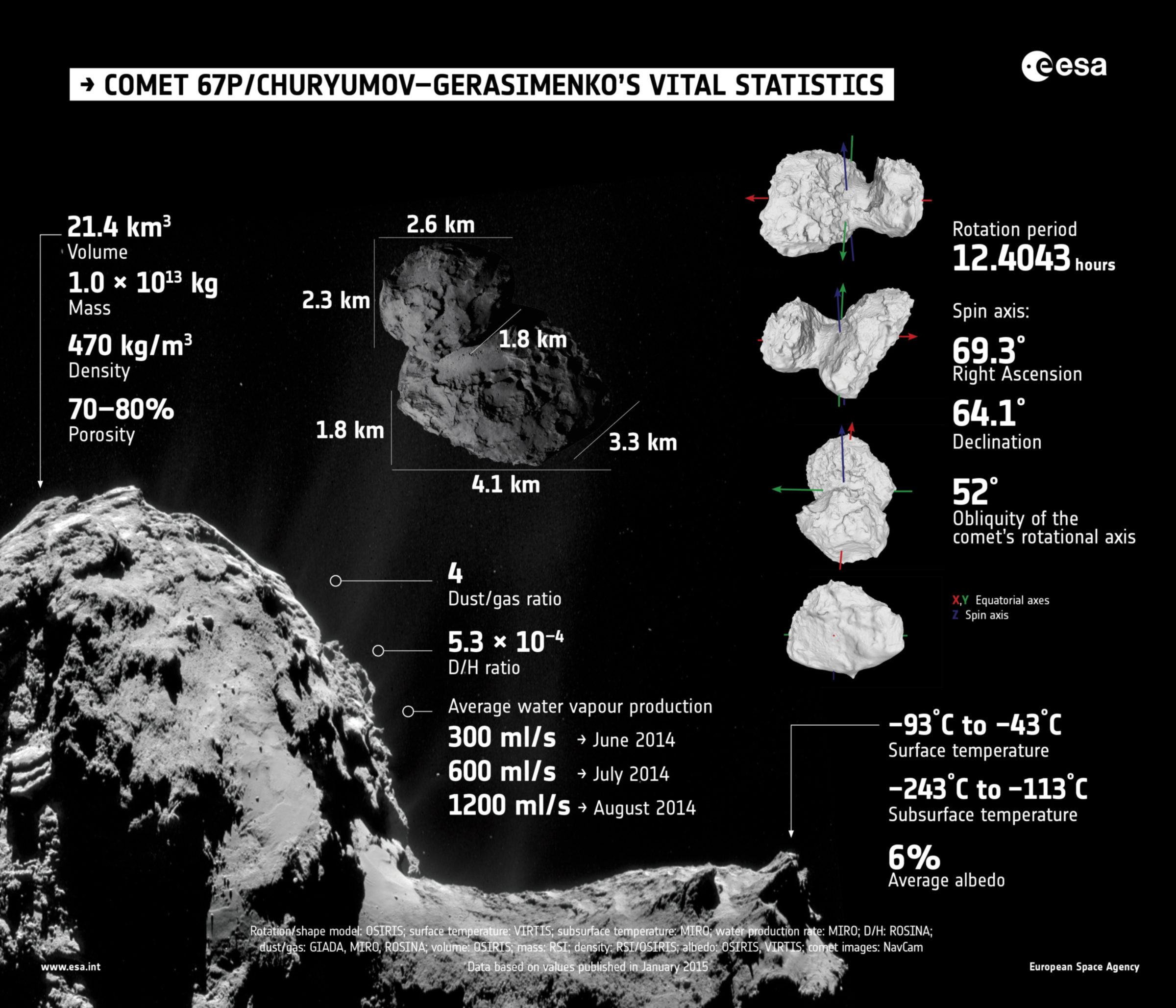
The fact that I found most striking in here was the 70-80% porosity. I had a hard time wrapping my mind about what kind of interior structure could create such a huge amount of void space, but I looked up a paper on snow physics and found that this this is actually quite a bit less porous than fresh snow, more in the neighborhood of wind-packed snow or melt-freeze crusts atop snowbanks. Of course, the comet isn't just made of water ice; it has other ices of varying densities, and also organic and silicate materials, too. But I'm somewhat relieved by the fact that, the pososity of an icy world with nearly zero gravity is in family with snow.
One very curious aspect of Churyumov-Gerasimenko is how lacking in color it is. Sierks remarked in his AGU talk: "There is no color variation. Except a very few points, if you zoom in, you see some bright material falling off cliffs that are slightly less red in spectral data." The comet is everywhere the same shade of extremely dark brownish black. To my mind, that suggests that everything is mantled with some kind of dust, the way Mars looks the same shade of red everywhere because of its ubiquitous windblown dust. There are only a couple of spots where the OSIRIS team members saw any color or albedo variation. Here are two examples:

Is it comet dust? It's hard to say. Some areas of the comet's surface are clearly covered with granular airfall material, which makes for smooth plains and softened-looking surfaces. This material probably comes from comet jets: "any ice chunks or particles larger than a few millimeters that are emitted from the source will not sublimate before falling back and could therefore form...ice deposits." Take this round depression, one of the few examples of possible impact craters on the comet. The 35-meter crater appears to be covered by airfall material with a depth of 1 to 5 meters (based on standard depth-to-diameter ratios for craters), according to the morphology paper.

Some locations even contain dune-like features. In the morphology paper (and the captions posted with the images on the ESA website), they make it pretty clear that they believe that the dune-like appearance of these features is no coincidence; these really are wind-caused features. How can you have wind on an airless, nearly gravity-less body? Well, there are vents, and gas does come out of vents, and those may cause the kinds of shear stresses that could lift surface particles. They estimate that gas velocities of 300 meters per second are large enough to lift 100-micron particles. However, my notes from AGU indicate that there isn't consensus on the idea of these dunes being aeolian. Olivier Groussin -- who is, by the way, the 28th of 59 authors on the morphology paper -- remarked something to the effect of "I am not convinced they are actually dunes. You need good wind in good direction at good speed. Can you make them by compression or sliding? 'Dunes' is the word we've been using, but probably we will not be using it in next weeks or months."
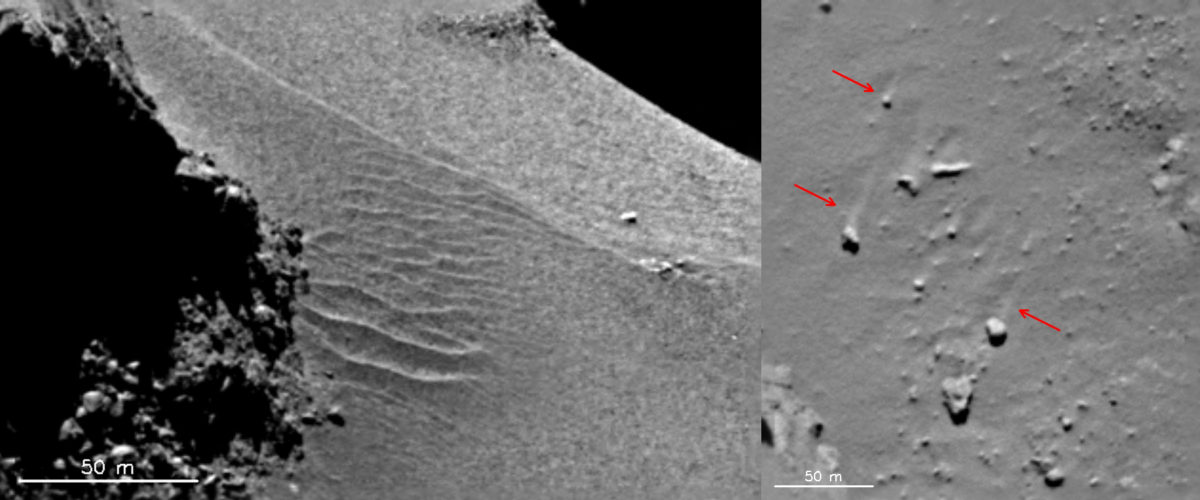

Although the dune-like features are interpreted here to be made of fluffy, unconsolidated material, the morphology paper goes on to say that once material falls out of the sky onto the surface, it may not stay so fluffy. I was really struck by this sentence: "Given the likelihood of a high organic content for the airfall deposit (e.g., cometary tholin) and exposure to sunlight, the production of a form of organic, possibly polymerized, matrix from this deposit (after the loss of any volatiles) is also conceivable." You know, we have a lot of polymerized organic material on Earth. We call that "plastic." Is the surface of this comet made of powdery snow cross-linked by a matrix of plastic?
However, there are large areas of the comet that do not appear to be covered by soft, fluffy stuff. Some areas form very steep cliffs, with slopes in some spots reaching greater than 45 degrees, particularly the steep, striated cliffs of Hathor, bordering the neck. In fact, according to the morphology paper, the 900-meter-tall cliff of Hathor is "roughly parallel to the local gravitational acceleration," that is to say, it's nearly vertical. They see vertical linear features as well as "roughly perpendicular linear features aligned with small terraces, which might suggest inner layering." They think that this is an eroded surface and therefore that Hathor is "showing us the internal structure of the head." The nucleus paper speculaets that the cracks might result from thermal shock, due to the huge variety in temperature that the comet experiences along its orbit, up to 150K.
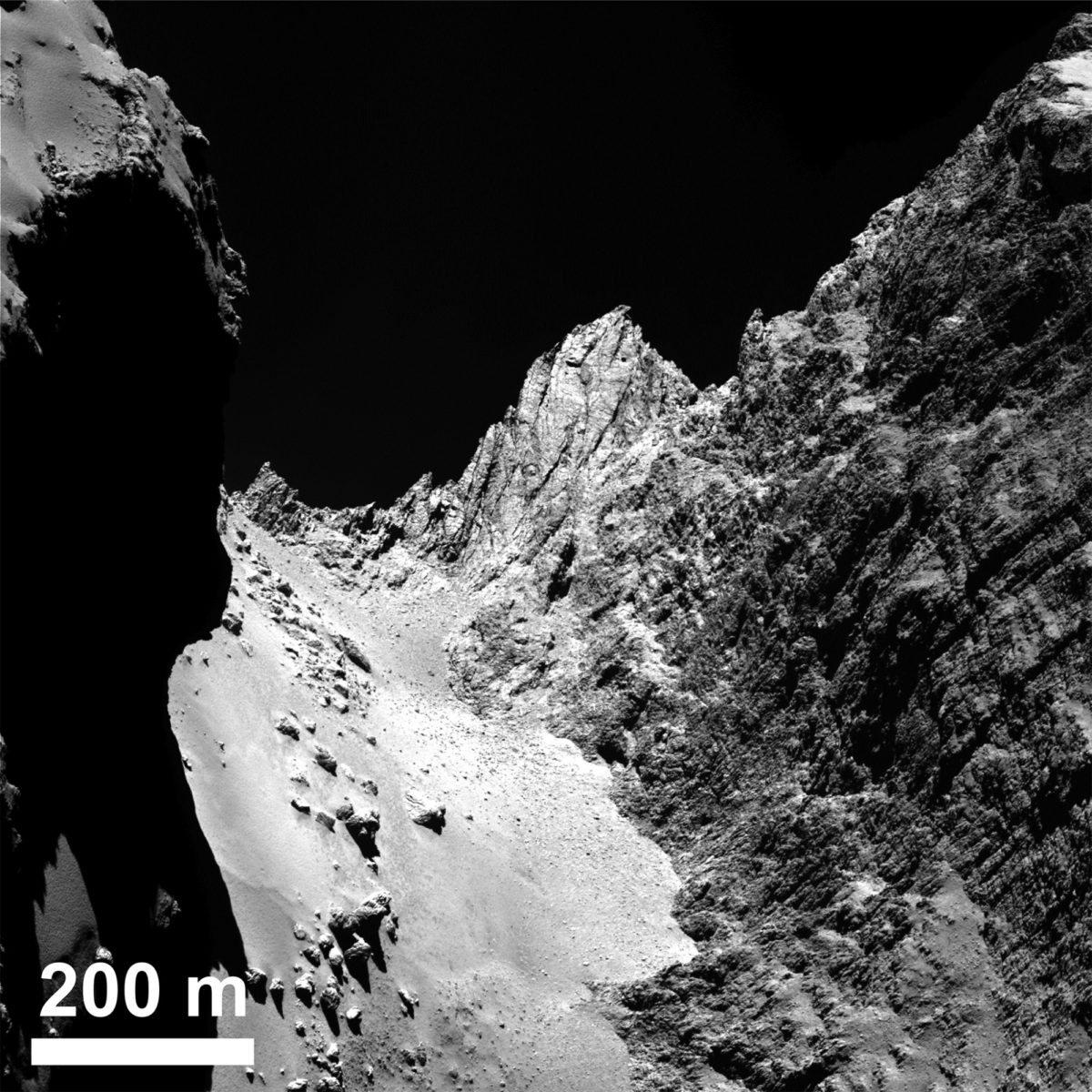
The subsurface is competent enough that it can exhibit parallel sets of fractures, sometimes everal criscrossing sets like the ones in this photo.

There's another kind of fracture that appears markedly different. It crosses Anuket, and appears to split the head and body:

A particularly cool feature of this fracture is what it does when it crosses into the softer surface of Hapi. It turns into a chain of pits, meaning that as the crack opens, loose material from Hapi is falling down into the void.

There are lots of other features on the comet that suggest ongoing mass wasting processes:

Some of the most impressive features on the comet are circular, flat-floored, steep-walled depressions, like this one in the Seth region. They bear similarities to features comet missions have seen before, on Wild 2 and Tempel 1. It's clear from the OSIRIS images that at least some of these host comet jets, which become visible when you crank up the contrast in the photo:
How do these depressions form? My notes from Olivier Groussin's talk at AGU suggest he thinks they've always been there, but I'm guessing this is a topic of much internal team debate: "Are these primary voids, from their formation process, or evolutionary voids, from activity? I tend to favor the first scenario, because the second requires large mass loss. The depth-to-diameter ratio is much larger than craters; think they are collapse pits like sinkholes. It's not due to erosion, probably. Erosion is happening there, but it's not the dominant process. Also erosion would not create circular features." Later in his talk, he mentioned that "large primordial voids imply a gentle formation process," with comet-forming material accreting at low speeds, in the neighborhood of a meter per second.
That image, of the pit in Seth, was taken quite early in the orbital mission, from a great distance. When Rosetta got closer, it saw very strange details in the walls of those pits. At AGU, Holger Sierks called these "dinosaur eggs." They've since changed the metaphor to "goosebumps." The nucleus paper describes them thus: "The bumps themselves exhibit a characteristic scale of about 3 m. Although we do not yet have an interpretation of these features, the fact that a single characteristic scale is present may be an important clue to formation processes, as many of the possible processes have characteristic scales." Since they presumably represent the interior structure of the comet, I'd like a more three-dimensional metaphor: maybe gumballs, or the pebbly texture of expanded polystyrene foam. Sierks talked about these features at length at AGU. What are they? We don't know. I think they're the most intriguing and unusual thing OSIRIS has discovered so far. I wish these two images hadn't been so badly munged up before release.


All of the OSIRIS images shown in this post are image files that were prepared for print publication, and as far as I can tell, almost all have been cropped, resized, and processed in different ways before being posted to the Web by ESA. My guess is that they were placed in some kind of desktop publishing software before being exported; in many cases the gray levels in the original images were smashed down into a 16-level color table, with dithering, and were then enlarged at least twice before export (once by a nearest-neighbor process and once with interpolation). All that processing destroyed subtle shading and detail -- in particular, it made it impossible to see features in shadows, or bring out jets and coma material in the sky beyond the comet. So we're not really seeing anything like the full capability of OSIRIS in most of these images. Some of the most ridiculously enlarged photos I downsized before posting here in order to make them play nicer with your browsers.
ESA released one final image as part of the press release, which was used on the cover of Science -- since it is 2048 pixels square, I think this is the only one that actually represents the pixels as they came off the detector. It's also the most recent image of the bunch, acquired three months ago.
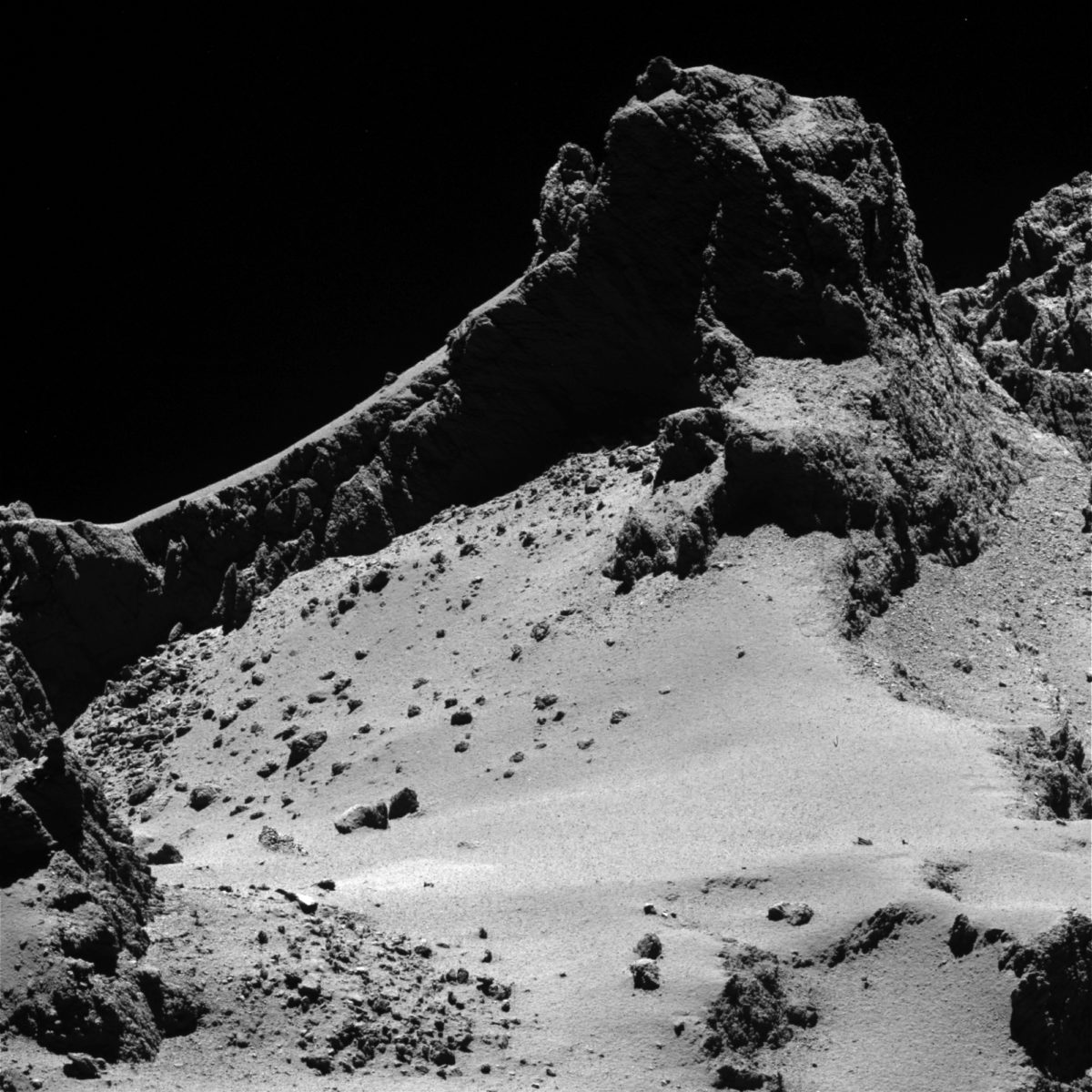
In this image, at least, fine details lurking in the shadows have not been destroyed by processing. Enhance the contrast and you can see beautiful intersecting sets of fractures in the cliff wall, lit by the wan light reflected off the smoother plains below the cliffs.
Untold treasures await among the vast archive of image data being gathered by Rosetta. Mark your calendars -- the first pile of data should be released to the public on May 19, 2015, including images gathered up to November 19, 2014.
Support our core enterprises
Your support powers our mission to explore worlds, find life, and defend Earth. You make all the difference when you make a gift. Give today!
Donate

 Explore Worlds
Explore Worlds Find Life
Find Life Defend Earth
Defend Earth




